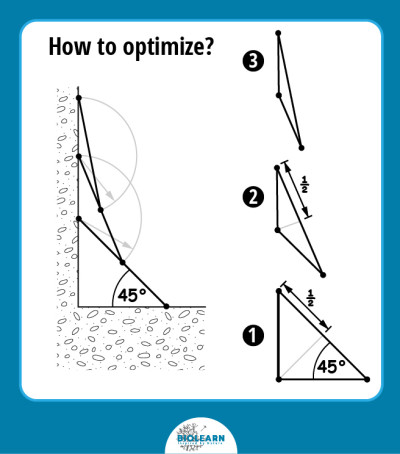To Break or Not to Break?
In this activity, pupils explore how nature uses curves to create strength.
Age Group: 9-12 years
Duration: 20 minutes
Biomimicry Connection:
We hardly find sharp corners in nature – this is mostly because nature tries to avoid cracks by using curves. By observing stable constructions (like trees) in nature we can learn what shape they use.
Activity Details:
Tools and Materials
- Tray – 1 per group
- Transparent plastic objects (ruler, Sellotape holder, CD case, etc.) – 1 per group
- Polarized sunglasses – 1 per group
- Electronic screen with white background – 1 per group
- Transparent film (PETE) – whole, cut in a right angle, cut in a quarter circle, cut in a curve – 1 series per group (see Preparations below)
Preparations
Prepare the materials listed above, and place one set in a tray per group. Make the transparent films according to the following description: See Figure 1 below
- Cut each film into squares 10 cm square; three squares per group
- Cut out ¼ square from one film per group (cut at 90 degrees).
- Cut out ¼ square from one film per group in such a way as to draw a quarter circle with a coin at the bend. Cut it for a while, put the coin there and draw a quarter circle, then draw a line to the edge of the film (quarter round arc).
- Cut out a ¼ square from one film per group by drawing a hyperbola on it based on Figure 1 below.

Description
You should already have tried the Starter Activity (in the biomimicry story) trying to break an egg with bare hands. This was difficult. Although eggshell is thin, the shape of the egg helps dissipate forces evenly to increase its’ strength.
Why is the curved shape important? There are no obvious stress points, and because of this, it breaks only when we apply a lot of force. Stress points are affected by shape. For example, a right-angled bend will have different stress tolerance to a curved angle. We will observe this in the four-step experiment below using polarized light and a polarized filter.
Ask pupils to get into groups of 3-4 children.
- Turn on the computer, open a white page on the monitor (e.g., Paint or an empty Word document). Tell pupils to put on their polarised glasses. Then, take the plastic objects from their equipment tray and hold them in front of the monitor. Move it gently, bend if it is flexible.
- Both the screen and the sunglasses contain a polarizing filter, which helps to filter out scattered light, which makes the mechanical tension within the material visible. Where there is a change in the density of material, the white light breaks up into its colours. Watch the coloured ‘bars’ appear and change. The coloured bands show where there is tension in the material. In some places the bands are thick and there are few of them, in other places they are narrow and close together. Where they are densest, there are the so-called stress points. If the material is subjected to an external force, they break or tear here.
- Take out the film that is cut at 90 degrees. Bend this too, observe where the stress points appear and how their arrangement changes as you move the film. The stress-centres are concentrated at the corner.
- Now explore the film with the quarter circle cut out. Bend this too, observe where the stress points appear and how their arrangement changes as you move the film.
- Fewer stress patterns are visible, but they are still there. Is it possible to create an even more effective curvature so that the number of stress points is reduced to a minimum? What helps to conduct the force acting on the body safely, without breaking, through the material?
- Finally, examine the film cut in the shape of a hyperbola.
Explanation
In the case of an arch, based on the curvature of the wood, the tension on the film is further reduced. The curvature at the base of the wood is optimized to evenly distribute the stretching stress, thus avoiding the occurrence of breaks/cracks due to mechanical impact. This type of curvature is very effective in avoiding stress build-up at any point in the arc.
The polarised glasses and screen make visible where there is mechanical tension in the material. This is what the coloured lines show: where they are denser and narrower, there are stress points. That is, if it is subjected to an external force (for example, you bend the ruler strongly), then it will break there.